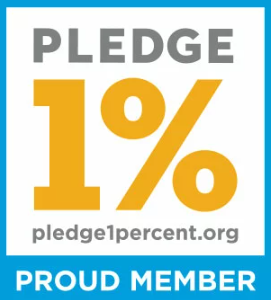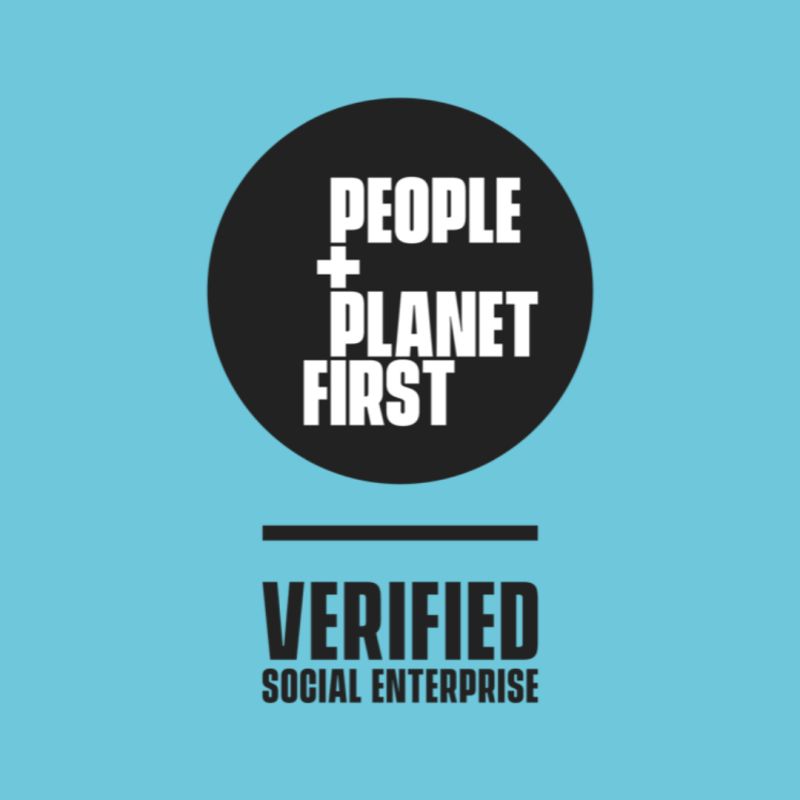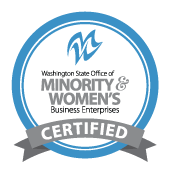
What is Your Brand Experience?
When you walk into a room, what is your brand experience? Your energy creates a message whether your mouth is open or not. Consider that how people experience you markets you more than words or even your actions. When you energetically align who you are with what you offer, your impact magnifies–attracting clients to you for reasons they may not even be able to put into words.
Here’s an example. I was 22. Just graduated from the University of Washington, I had no clue what job to get. I was a broke, art major with no connections, experience or money, and went to a career fair and lined up 10 interviews. At each interview, I resonated with their energy or not and kep asking myself “Do I want to become like this person interviewing me in 5-10 years?”
I ended up going with a small financial planning company promising great training and support with unlimited growth potential. But it wasn’t just the benefits that sold me. The final gut check whether to accept a position was resonating with the interviewer’s energetic presence. In this case, it was Eric who showed up as super down to earth, authentic, straight, and quite simply, I trusted him. He became my business manager and trainer, who supported, coached, and trained me to gross six figures by age 23.
My mentor’s presence or brand experience resonated the loudest.
You might be wondering now, what is my brand experience?
Rather than guess, you can just find out by asking. Even strangers! You might be waiting in line at a store. And you can ask the checkout person, “Hi! I’ve discovering what kind of impression I leave on people. Would you mind if asked you for some quick feedback? In 1-3 words, what’s your first impression of me?” You could ask a neighbor walking by, or you kid’s childcare drop off person.
I’m always shocked by what strangers intuitively get about you without ever talking! It helps me gauge in reality who I’m being in the world at a particular point in life.
If you’re shy to ask strangers, just do it and practice facing your fear. Or you can ask people you know, love, and respect. Simply email them “Hey there! I’m doing an experiment. Quick question: When I walk into a room, what are the first 3 words that come to mind?” Again, having tested this experiment numerous times–many times with the same friends over the years–those three words evolve as you grow and point to your brand experience. [NOTE: Every now and then, there might be a hiccup in your relationship to address first before getting feedback (clean up any unfinished business!) but 99% of the time, my heart is warmed by their responses.]
Then compile their responses, and see if any patterns emerge. Ask yourself, is how you’re showing up lining up with your business’s core values and mission? If it does overall, awesome! You are energetically aligned in your business. If not, see what value is missing that you are not embodying. Or perhaps it’s the other way around–you are embodying a value so vibrantly and it’s not incorporated into your business.
That’s what I discovered. Most of my friends and strangers have said the words that come to mind are “energy” or “enthusiasm.” At the time, my business did not have that value anywhere. I was wasting a huge, natural character trait I could integrate with my business. I did. I created the ENERGY core signature coaching program and started to embed elements of energy everywhere–in my logo, marketing materials, trainings, and even in making decisions for which marketing strategies to best implement. Speaking was where my energy could most resonate and impact with others making follow-up calls super easy to convert into clients.
When you energetically align your business–your presence magnifies. Your brand experience clicks for those you come into contact with, and frankly, sets off the Law of Vibration or Law of Attraction for whom you want to do business with. In short, you naturally attract the right clients.
Your turn:
What is your brand experience?
Does your brand experience align with your vision, mission, and values?
What’s your vision beyond making more money?
Remember, the stronger you are aligned from the inside out, the more others can experience your business presence and resonate with your message to attract your tribe of clients.
Anna S. Choi helps mission-driven, conscious entrepreneurs attract more clients through business coaching and training. She loves synthesizing, distilling, & customizing strategic marketing plans into executable daily actions to grow your business. If you want more focus, accountability, and peace of mind day to day while implementing an intentional strategic marketing system to attract more clients, learn more at www.annasunchoi.com.
Why Should You Invest in a Business Coach?
You don’t. That’s right, I’m a business coach saying you don’t need to invest in a coach. Here’s the deal: It is only when an entrepreneur is hungry for growth and transforming where they are now that a business coach even makes sense. What matters most is your mindset.
Any Olympic athlete knows a coach is required for high level performance and winning the gold. You would never see an Olympiad reading an article on whether to have a coach. Being up to a big game to win the gold, she already knows a coach is required for her performance. It’s her mindset of winning the gold that determines her actions of what coach is best for her.
On the other hand, a recreational soccer league player would question having a coach. In fact, you likely don’t need one! A coach isn’t necessary. You only need a coach to the degree you are playing a bigger game. No big game, no coach needed.
Now, if you’re reading this, I know you’re a performer who IS up to a bigger game. You have a growth-oriented mindset and is interested in expanding on your current successes to manifest a bigger vision. Or perhaps you are someone who’s accomplished a lot and are now looking at how to uplevel your performance, switch careers, or scale your company.
Whatever stage you’re business is at, here’s the litmus test whether you know you’re ready for a coach. Entrepreneurs invest in coaching for primarily 3 reasons:
- You cannot grow your business on your own. And you have the courage to admit it.
- You want to grow your business faster. This is often due to urgent circumstances to cause a particular result in a short time frame.
- You want to be as efficient as possible and follow a proven methodology versus reinvent the wheel.
If you can answer yes to at least one of those questions, I’d recommend interviewing business coaches. When hiring a business coach, here is a mental checklist you might use: Do you share a similar philosophy? Do you enjoy each other’s presence? Does the coach have credible success stories of their clients? And the most important question of all: Am I up to a bigger game? In other words, what’s your mindset?
The answer to that question won’t be inside your head. Stop consulting with yourself–it can be a bad neighborhood of overused past based neuronal patterns designed to help you survive. Instead, interview some loved ones and discover how you’re showing up. Then choose.
As many entrepreneurs discover, business is not for the faint of heart. If you want to catalyze your dream lifestyle and the difference you want to make in the world, a coach simply helps you do what you could not on your own, helps you utilize proven methodologies and systems, and ultimately, helps you achieve your dreams faster.
Anna S. Choi helps conscious companies grow their client flow through business and marketing coaching. She loves synthesizing, adapting, and distilling strategic marketing plans into executable daily actions to take that get results to grow your business. If you’re interested in taking focused action on an intentional strategic marketing plan to energize more client flow, please watch this introductory video to see whether we are a fit. I look forward to connecting and supporting you! You can contact here.
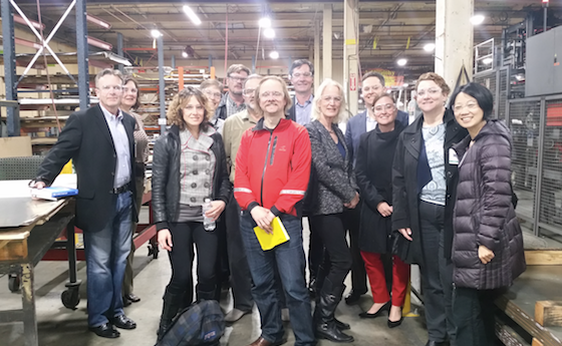
Game Changer: $80 Million Dollar Social Enterprise, Pioneer Human Resources and Industries
Game Changer: $80 Million Dollar Social Enterprise, Pioneer Human Resources and Industries
On March 29, 2017, Social Enterprise Alliance of Washington State kicked off its first annual event for the year featuring Pioneer, an $80 million social enterprise serving people released from prison or jail in Washington State, and those in recovery from addiction
who are in need of treatment, housing and job skills training. Pioneer helps people rebuild their lives after jail or prison with counseling and treatment services, and supports the transition from prison with training and job opportunities.
Pioneer is game changing the statistic that 68% of those released from incarceration return back behind bars. Rather than giving “hand outs,” Pioneer believes in “hand-ups”, by first ensuring basics needs like housing are met. Then they begin focusing on providing job skill development, training, employment, and certifications and the ability to successfully start a new life on a healthy path and often hire people with criminal backgrounds for it’s manufacturing arm Pioneer Industries.
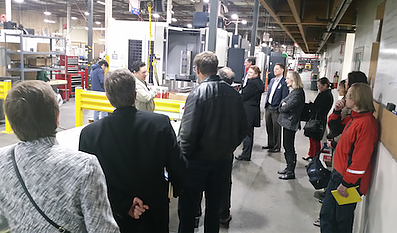
Pioneer Industries fabricates sheet metal and manufactures machine parts for companies like Genie, which sell construction equipment. Pioneer Industry’s most recent investment includes purchasing a $750,000 state-of- the-art machine that manufactures parts for Boeing airplanes.
Pioneer hires employees based on merit and best fit and don’t discriminate based on past criminal history. This unbiased hiring process not only allows a way for those getting out of prison to be considered for employment, but allows for “the cream of the crop” to rise up. On the tour, Pioneer Industry’s hiring manager shared how people out of jail or prison tend to make the best employees. They are the most hungry to improve and make the most out of their job to make a better life. In fact, 65% of Pioneer employees are formerly incarcerated. On the manufacturing floor, there’s no way to know whether someone was incarcerated or not in the workplace culture—everyone is treated equally and up to the employee to disclose.
Because of the plant’s collective commitment to quality control, and taking pride in their work, they are consistent in meeting high expectations for production and delivery of quality products. As a result, they have built a strong reputation and respected business!
Revenue generated from Pioneer Industries successfully funds, grows, and sustains Pioneer as a social enterprise. They’ve only begun to look at traditional non-profit financing in the form of grants or stewarding large donors. Pioneer is an organization worth modeling, successfully integrating both mission and market driven approaches. Social Enterprise Alliance Washington State is proud to introduce you to a social enterprise model that works well. Imagine if all organizations were both mission and market driven?
Anna S. Choi helps conscious companies grow their client flow through business and marketing coaching. She loves synthesizing, adapting, and distilling strategic marketing plans into executable daily actions to take that get results to grow your business. If you’re interested in taking focused action on an intentional strategic marketing plan to energize more client flow, please watch this introductory video to see whether we are a fit. I look forward to connecting and supporting you! You can contact here.
The Renaissance Soul: The Myth of having One True Calling
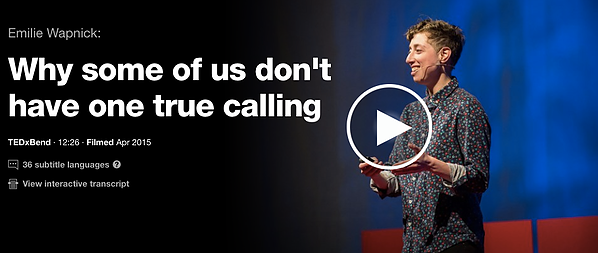
In her talk she highlights how we need to nurture multipotentialites who offer three superpowers:
- Idea Synthesis
- Rapid Learning
- Adaptability
She closes her TEDxBend Talk underlining how “Idea synthesis, rapid learning and adaptability: three skills that multipotentialites are very adept at, and three skills that they might lose if pressured to narrow their focus.
As a society, we have a vested interest in encouraging multipotentialites to be themselves. We have a lot of complex, multidimensional problems in the world right now, and we need creative, out-of-the-box thinkers to tackle them.
. . . let’s say that you are, in your heart, a specialist. You came out of the womb knowing you wanted to be a pediatric neurosurgeon. Don’t worry — there’s nothing wrong with you, either
. . . In fact, some of the best teams are comprised of a specialist and multipotentialite paired together. The specialist can dive in deep and implement ideas, while the multipotentialite brings a breadth of knowledge to the project. It’s a beautiful partnership. But we should all be designing lives and careers that are aligned with how we’re wired. And sadly, multipotentialites are largely being encouraged simply to be more like their specialist peers.
. . . embrace your inner wiring, whatever that may be. If you’re a specialist at heart, then by all means, specialize. That is where you’ll do your best work. But to the multipotentialites . . . to you I say:
embrace your many passions. Follow your curiosity down those rabbit holes. Explore your intersections. Embracing our inner wiring leads to a happier, more authentic life. And perhaps more importantly — multipotentialites, the world needs us.”
The Renaissance Soul
Margaret Lobenstine, author of The Renaissance Soul characterizes Renaissance Souls as folks who:
- Prefer variety over single minded focus
- Have a working style emphasizing growth and evolution instead of rigid adherance to a plan
- Define success by challenges mastered instead of how far up the ladder they’ve climbed
They are NOT people who are geniuses, job-hoppers, use business as an avoidance mechanism, are superior to others, have ADD, or are jack of trades master of none.
In fact, consider this role model Renaissance Soul who clearly demonstrates jack of all trades, master of all!
-Served as a journalist in Ghana & Egypt
-Composing songs for popular singers like Harry Belafonte
-Lecturing to packed auditoriums and appeared on innumerable talk shows
-Acting, both on camera and on stage
-Received nominations for both the National Book Award and Pulitzer Prize
-Working with Dr. Marting Luther King, Jr. For civil rights
-Singing jazz
-Holding a professorship in American Studies
-Dancing it the opera Porgy and Bess
-Speaking eight languages
-Serving as America’s poet laureate
Who is this? The one and only Maya Angelou, my new hero. I had no idea the degree to which this woman mastered innumerable accomplishments across a wide variety of disciplines.
Case Study: Myself
When I was 18, I remember sitting in my Nissan facing the Columbia River. I said aloud to myself, “Is this it?!” I thought I had it all: ASB Vice President, Scholar Athlete, competing classical violinist winning several gold and silver medals, awarded numerous college scholarships, lead actress in a musical, voted by peers as most loving leader, had a hot boyfriend from the big city, and yet felt totally unfulfilled. In fact miserable.
I became consumed with the question “What’s my purpose?” forcing myself to choose one pathway–convinced if I just mastered other areas, perhaps one area would resonate above all areas, then I would find my calling and be fulfilled.
So at 19, I interviewed ten human beings I looked up to and discovered eight of them had majors completely separate from their career! I concluded (in this field research) that I would major in whatever fulfilled joy in my heart.
I majored in art. Interdisciplinary (of course!) art. I dove in deep, spending hours and hours drawing, building wire framed pants, creating yarn spiderwebs at dawn. I studied abroad in Rome Italy, turning fish cartons into a palate for a painting. I got commissioned as an artist, had my work featured in a museum and local magazine, and was even told by my art professor (who are famous artists!) an affirmative “you can make it” as an artist. Despite all this, I found myself picking up a second major in Community, Environment, and Planning and founding a student organization InsideOut Leadership.
What was wrong with me? Why couldn’t I commit?
Consider human beings live in a culture that calls for and even romanticizes the “one calling” versus multiple callings that often can have Renaissance Souls forcing themselves into a box by focusing on one specialty, feeling trapped to pursue for the rest of their life! No, you don’t have commitment issues. As typical of a Renaissance Soul, I had mastered the challenge and once I knew the game could be won, went on to the next challenge, rather than expand and grow it bigger. I had no qualms about becoming a Financial Advisor as an art major…who soon sold her business after five years to be a stay at home mom. The go on sabbatical, publish a children’s book, and yes, start a business in event production.
Pivoting, rather than growth and expansion, are far more delectable for the Renaissance Soul. Find out if you are a Renaissance Soul here. While I fear my community may be confused on the changes to different fields, the idea synthesis trait allows me to find a common thread in my mission, as well as find peace in pursuing mastery of many passions.
From one Renaissance Soul to another, here are two frameworks I’ve discovered that create peace of mind:
1. Draft a mission statement that embodies your top 3-5 core values. This mission becomes the umbrella theme over all your passions. My mission is to empower the next generation of leaders. This common thread can be found in my art, financial planning, gender equity activism, event production, and dancing. Your mission creates a personal brand that allows others to comprehend, remember, and connect for themselves how what you offer contributes to their communities.
2. Live life in 3-5 year increments. As the author of your life, make every 5 years (or whatever time frame works for you between 1-10 years) be a new chapter encompassing your new passion! Ie. I focused on art for 4 years, financial planning for 5 years, motherhood and children’s education for 3 years, etc. Instead of waiting for retirement to have permission to create a new chapter, author many chapters in your life!
Thank you Margaret Lobenstine (who has since deceased in 2015) and Emilie Wapnick for your work in creating a home for us jack of all trades, masters of all! This Renaissance Soul can find peace of mind surrendering to her true nature. Home at last!
Anna S. Choi helps conscious companies grow their client flow through business and marketing coaching. She loves synthesizing, adapting, and distilling strategic marketing plans into executable daily actions to take that get results to grow your business. If you’re interested in taking focused action on an intentional strategic marketing plan to energize more client flow, please watch this introductory video to see whether we are a fit. I look forward to connecting and supporting you! You can contact her at anna@annasunchoi.com or 206-330-6426.
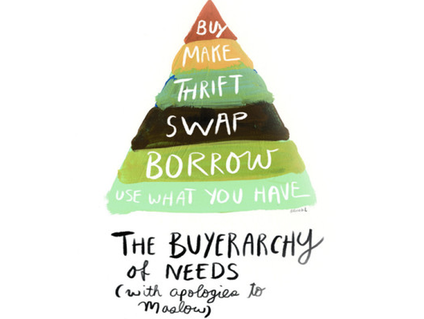
Buyerarchy of Needs
As we head into the holiday season, I’m looking for an alternative for both buying and receiving gifts. My family started a new tradition of picking a cause that the other family member donates to. While that tradition only lasted a couple of years, I found myself wanting
I first got educated out of stuff coming across Annie Leonard’s 2007 Story of Stuff video.
It’s education that you don’t really want to know, and yet deep down inside–you do believe it’s your responsibility to at least get educated. So I watched the video, learning the entire supply chain of “stuff” from electronics and smartphones to plastic toys. By the end, I was now questioning everything I owned and thus began my conscious consumerism.
Learning where stuff actually ends up can feel daunting. So rather than overwhelm you into inaction, here are a few ideas to inspire you as a conscious consumer:
1. Start a new holiday tradition with creative gifting either by donating to a cause, making jams or soaps, or gifting an experience like cooking classes.
2. Check out New Dream.org‘s Simply the Holidays link where you can get ideas for fun holiday tradition gift alternatives. I love their take-home message:
“Part of being a conscious consumer is educating ourselves about the hidden costs behind the things we buy. But we also need to consider what’s driving us to buy these things in the first place: will they really enhance our lives and make us happy, or are we buying them simply because we “think” we need them or because advertisers tell us to?”
3. Finally, you practice living by Sarah Lazarovic’s “Buyerarchy of Needs” who did a one year social experiment where instead of buying whatever she wanted, she painted what she wanted to buy for a year. She came up with this cool Buyerarchy of Needs.
Whoops! The Power of Owning Mistakes
Leveraging Mistakes into Opportunities to Build Trust
Beep! I look down at my text which says “Anna, I’m trying to buy tickets to the Creativity Symposium and the website says they are no longer available.”
Huh? This is ironic. Our team has done tons of marketing, pushing the final days of our early bird tickets only to find that people trying to buy a ticket–cannot. I found the mistake: I accidentally programmed the wrong expiration time for 12/31 at 12:30am instead of 1/1 at 12:30am. I had lost a day of sales on the biggest day for selling tickets because I didn’t double check the expiration time on the ticket site.
Now is the moment of truth. I could fix it, text my friend it’s fixed, then simply pretend like it never happened to the public. Why acknowledge a mistake? It only affects a few. Plus it looks bad, right?
You’ve heard it before: “Put your best face forward,” “Fake it til you make it,” or “Look as good as possible, leave no room for obvious error.” As my former boss at a wealth management company said it, “I hate to say it, but yeah–we have to be perfect.” Phew! Talk about pressure.
At Start Up Seattle, Shauna Causey, a former Executive at Comcast, shared how she risked her job by tweeting a mistake the company had made that resulted in customers not having internet access for several hours. Rather than cover it up with PR, she simply said what happened and apologized publicly, against the company policy. From her bold ability to embrace the mistake publicly, Comcast sales actually skyrocketed following the incident, customers appreciated the integrity. She kept her job, and even got recognized for it, eventually being promoted.
In this new year, what if mistakes were awesome? What if mistakes were treated as opportunities to build trust rather than something to cover up? Clearly, nobody’s perfect. We are just human.
There’s a wonderful little book called “Beautiful Oops” where all the pages intentionally are torn, they have holes; in essence, it’s as if a toddler had gone through the book. I bought it for my son Eli in hopes of teaching him the beauty of mistakes and failure. Then holding my tongue as he tears up the pages you’re not supposed to tear. 😀
Imagine you’ve made a mistake. Now is the moment of truth. What if you boldly owned it 100%? In fact, you leveraged it as an opportunity to build trust. Heck, you could even get creative with how to turn that mistake into something bigger and better for everyone in the long run.
What would it look like if T-Mobile’s John Legere or Microsoft CEO Satya Nadella fully owned their mistake? That they really went all the way in how their comments didn’t work. Might that be a huge opportunity to build trust with not just their shareholders but the broader community and women in society?
Starting the Year Right
My volleyball coach Jennifer Tonkin said it best, “To gain confidence you must aggressively fail.”
What will you create with your mistakes next year?
What mistakes have you embraced from this year and last?
Be proud of your next mistake. There just might be some confidence waiting for you on the other side.
A Vision for Leadership Now
Right now, 57% of college grads are now women, yet less than 5% of women are CEO’s.
Imagine this: A female US President where nobody in the media makes any mention that she’s female. Gender is no longer a conversation. It’s normal that over half of CEO’s, congress members, philanthropists, etc. are women. Choosing career or family is no longer a hot topic. In fact, women are paid to go on maternity leave while men are free to be full time stay-at-home dad’s void of any judgment from any gender. There is equitable representation of global leadership to the populations they represent.
How Women (and the Men Who Think Like Them) Will Rule the Future
Best-selling author and Social Theorist of Consumerism, John Gerzema is a pioneer in the use of data to identify social change and help companies adapt and respond. This TEDxKC talk is based on his book with Michael D’Antonio, “The Athena Doctrine: How Women (And Men Who Think Like Them) Will Rule the Future” (spring 2013).
Gerzema and D’Antonio surveyed 64,000 people in 13 countries. The people surveyed were first asked to rank the top traits they wanted in a 21st Century Leader then afterwards, assign whether each trait was more masculine or feminine. Gender consideration was not part of the initial question–but the top traits people wanted most, across the board, were associated to be feminine. The bottom line?
Two-thirds of those surveyed said the world would be a better place if men thought more like women.
Here’s a sampling of the top traits that both genders thought embodied the best 21st Century Leader:
Cooperation, Communication, Sharing, Nurturing, Listening, Collaborating, Balance, Trustworthiness, Vulnerability
I personally feel affirmed that traits such as vulnerability are now gaining favor in the eyes of what people crave for in the 21st Century Leader. In my spare time, I lead Self Expression and Leadership Programs for about 30 local leaders over 4-5 month programs. Though petrifying, I shared publicly what I was actually dealing with as a means to inspire through failure. Instead of looking perfect–no chinks in this armor–I shared from the heart. Several people responded saying “Thanks for sharing what’s really going on. I am now inspired to be a leader knowing I don’t have to have it all together.”
In what ways are you using your feminine traits to lead? Which traits do you naturally embody?
Consider you are making a way bigger difference than you realize, right now, with your community around you. Discover the difference you make.
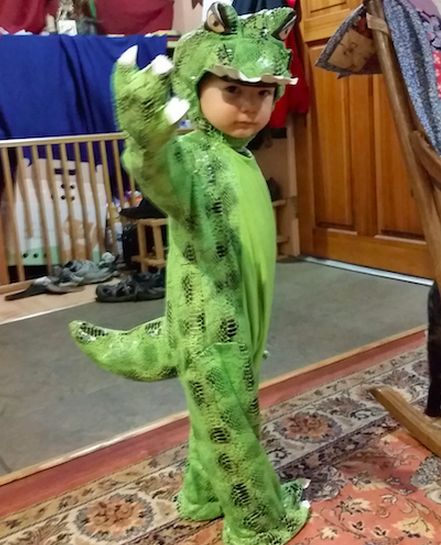
Unleash Your Inner Dragon
Here’s my son, Eli. He’s beckoning to you to let out that inner dragon. Did I tell you?
My Son has transformed into a dragon. When he’s got this creative costume on, he can’t help but breath fire, suddenly roar, and claw at the air. His creative costume helps him act in new ways. Now he may be a three year old playing around, but what creative costume could you “put on” to take action on what you have been procrastinating on?
Picking Your Creative Costume
What could you pretend to be that would create results in your day? There was a study showing two groups asked to reach for a doorknob as fast as possible to get the best time. Those who were told to pretend they were superhuman with lightening fast reflexes consistently beat the times of the control group. Mere imagination caused a new result in reality. So again, what’s your creative costume that will allow you to accomplish what you accomplish in your day to day projects to move forward?
A Case Study
My creative costume today was embodying Bruce Lee. Bruce Lee was a legend for many things, and quite notably this footage of him playing ping pong with nunchucks. Yes, nunchucks. I highly recommend watching this 3 1/2 minute clip to witness this inspirational act of sheer performance.
So I thought to myself, why not be the Bruce Lee of Time Management! I tackled my calendar like Bruce Lee hitting those ping pong balls and achieved more than I imagined was possible being myself. It worked.
Your Turn
Pick your creative character you can embody today. Pick a boring project or something you’ve been avoiding and choose the character that will be best to embody to get that task done. Discover the magic that unfolds not only to get the job done, but be fun and creative while you’re at it!

